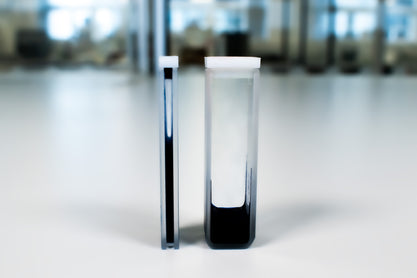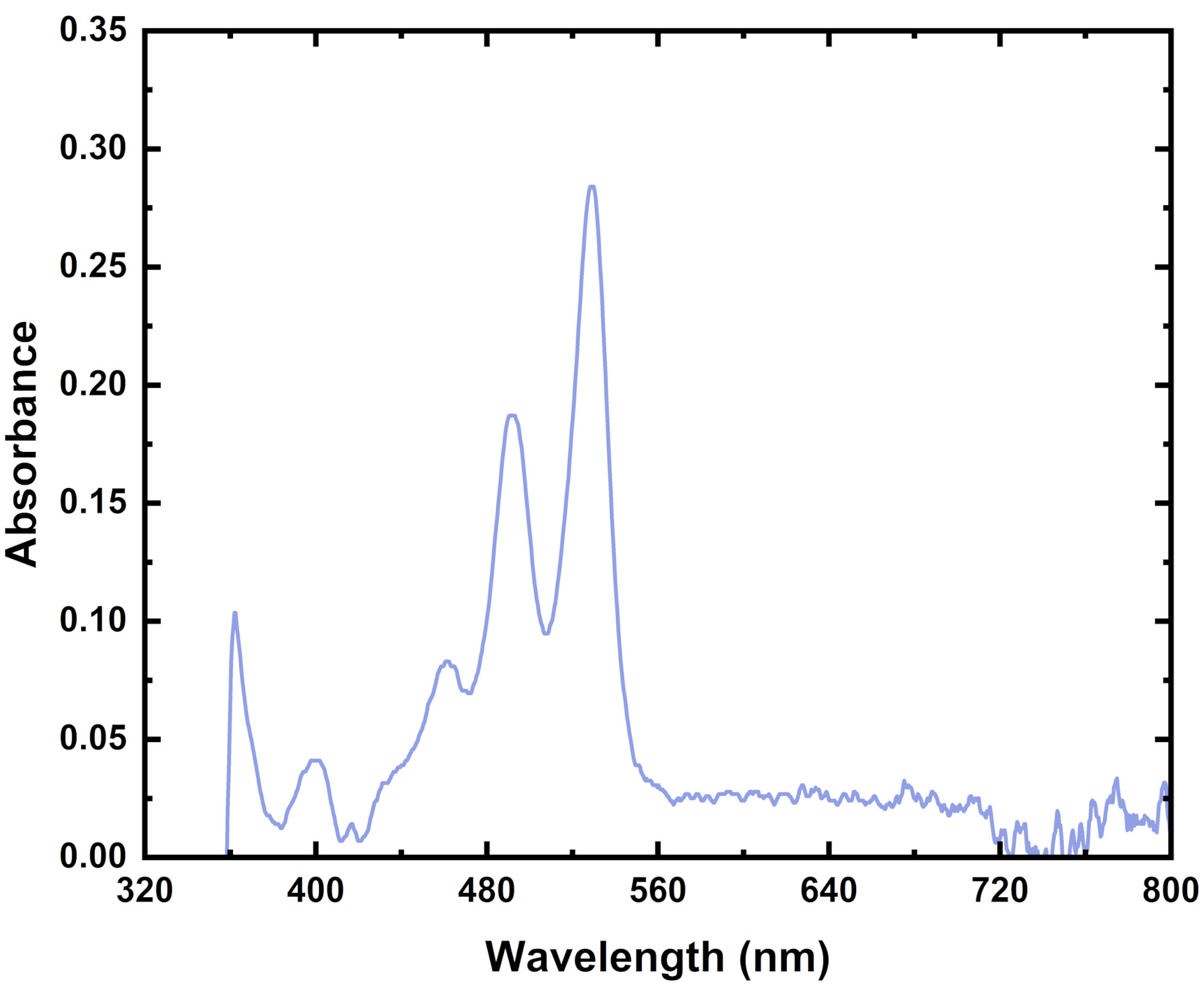Sample Preparation for UV-Vis Spectroscopy

When done correctly, UV-Vis (or optical) spectroscopy can be a powerful technique which can reveal intricate details about the molecular structure and optical properties of a sample. However, without well prepared samples, the results can be not only challenging to interpret but also potentially deceptive.
One important aspect of conducting UV-Vis spectroscopy is to have good sample preparation. There are many ways to prepare your samples. The right methods to use will depend on your sample and the type of spectrometer you are using. For example, the Ossila USB Spectrometer is perfect for taking quick UV-vis measurements to measure optical properties between 380 - 1000 nm. One key choice you will need to make is whether you measure your samples as solid thin films or in solution.
Preparing Solutions for Spectroscopy
It is often easiest to measure your samples in solution. To do this, you dilute a material in an appropriate solvent to a low concentration and take optical measurements using a standard quartz cuvette. This is a straightforward way to confine your material within a controlled environment of known path length. You can get standard size cuvettes with different path lengths, varying window transmission wavelengths and different window orientations. This makes it easy to find a cuvette that is suitable for your measurement.


One benefit of measuring solutions is you can also easily control, reduce, or monitor aggregation within your sample. You often need to use very dilute solutions to allow enough light to be transmitted through your sample. For example with absorbance measurements, if no light is transmitted through your sample, then no signal will be detected.
Additionally with solution measurements, sample temperature, pH and solvent choice can impact the measured optical properties.
To prepare your samples for solution-state UV-Vis spectroscopy, you should consider the following points:
- Ensure that your cuvettes are as clean as possible. If you can, put them through a standard glass washing procedure. At the very least, they should be rinsed with the last used solvent and a rinsing agent, such as acetone, deionized water or IPA.
- Before loading your sample, you should rinse the cuvette with the solvent that your sample is dissolved in. This should help remove any residual solvents left over from cleaning, which could contaminate your measurement.
- Any reference measurement, such as for absorbance spectroscopy, should be taken of the cuvette filled with the diluting solvent. This will ensure that your measurement will account for any optical effects introduced by the quartz cuvette or the solvent.
- Use an appropriate sample concentration. If your sample is too concentrated, the beam will not be able to penetrate through the sample, and no light can be measured by the spectrometer. If your sample is too dilute, light may pass through your sample without interacting with the sample material at all.
- Optimize the path length for your experiment. A cuvette’s path length is the distance that light travels through the sample before it escapes and is measured by the spectrometer. Using a cuvette with a smaller path length can be useful if you cannot reduce your sample concentration without significantly changing your results. Additionally, you can use a cuvette with a smaller path length to reduce the volume of sample needed. This can be especially useful if you have a small amount of sample or if your material is expensive.
- Ensure your spectrometer has a sample holder which accommodates your cuvette. The positioning of your cuvette relative to the spectrometer and light source should remain consistent throughout and between experiments. Your sample should also stand "face on" relative to incoming light to reduce any scattering effects. For example, the Ossila Optical Spectroscopy Kit contains a cuvette holder compatible with standard Quartz cuvettes.
- Always ensure that your samples are completely dissolved in your chosen solvent. Wherever possible, filter solutions before using to remove contaminants.
Preparing Thin Film Samples

There are some situations where it is more suitable to measure your samples as thin films. For example, reflectivity measurements (and some transmission measurements) correspond to the properties of actual layers in a device or coatings on a material. In these situations, measuring the sample in solution is not particularly useful. It is much more useful to study thin films to better represent the materials performance in their given applications.
When taking spectroscopy measurements on thin films, there are more factors to consider than for solution measurements. For example, you must consider sample angle and coverage. For absorbance measurements you must also consider reflection of light. There are some scenarios in which measuring the optical properties of thin films is too difficult, especially with low signal fluorescence. In these cases, it may be necessary to measure the optical properties of your material in solution.
As a sample moves from a liquid solution to a solid thin film, its optical properties may change due to aggregation. In a solution, particles are kept isolated, especially at low concentrations so you are measuring the optical properties of the monomer alone. However, as a solution becomes more concentrated, it is more likely to form aggregates. These will have different electronic properties than the individual monomers, often leading to a change in optical measurements. The formation of thin films involves processes that might exaggerate these optical effects. The material properties may change during film formation, as the film is being spin coated or during any annealing steps. For these reasons, it is often useful to be able to conduct UV-Vis measurements on solutions and thin films.
To prepare a thin film for UV-Vis spectroscopy:
- Ensure you are using an appropriate substrate. If your measurement or set up requires light to travel through the sample, such as absorbance spectroscopy, you should use a Quartz glass substrate. Quartz glass has high levels of transmission for both visible and UV light.
- If you are using a modular spectrometer, you should optimize your experimental set up. One factor to consider is the measurement angle of both the incoming light and the spectrometer relative to the sample.
- Ensure your sample is the right thickness. Similar to concentration for solution samples, varying film thickness will affect the measurements you take. If your sample is too thick, then the signal from the transmitted light will be too low to be measured. However, if the sample is too thin, the sample signal will be very low. If spin coating, film thickness can be changed by varying spin speed or precursor concentration.
- When preparing your sample, try and make your films as smooth and uniform as possible. Any defects, pinholes or inconsistencies in your film can affect your spectroscopy measurements. If you are solution processing your samples, thoroughly clean your substrates and filter your solutions before deposition.
- You should prepare the film so that the sample covers most of the substrate substrates evenly. This will make it much easier to conduct your measurement.
With modular spectrometers, you can easily switch between taking solution measurements and measuring thin films. For example, with the Ossila optical spectroscopy range, you can seamlessly shift between using the cuvette holder and the spectroscopy transmission holder.
USB Spectrometer

Learn More
 Absorbance Measurement
Absorbance Measurement
Absorbance measurements are crucial in many areas of scientific research. This article describes how to take an absorbance measurement using an optical spectrometer.
Read more... UV-Vis Spectroscopy Troubleshooting
UV-Vis Spectroscopy Troubleshooting
UV-Vis spectroscopy (or optical spectroscopy) is a simple, versatile and critical tool for sample characterisation. It is the most common type of spectroscopy, and a powerful method for analyzing material properties, allowing scientists to study a material's molecular properties, structure, and behaviour. UV-Vis spectroscopy can also be used to monitor reactions, identify materials for certain purposes and to investigate the molecular structure.
Read more...